#vedic wedding in vrindavan
Explore tagged Tumblr posts
Text
What will be the cost for destination wedding?

The cost of a destination wedding in Vrindavan can vary widely depending on various factors such as the number of guests, venue choice, accommodation, decor, catering, entertainment, and overall wedding arrangements. The cost of renting a wedding venue in Vrindavan can range from moderate to high, depending on the type of venue and its facilities. Heritage hotels, resorts, or banquet halls with scenic views and modern amenities may come at a higher price than more superficial venues.
#destination wedding in vrindavan cost#Budget destination wedding in vrindavan#Best destination wedding in vrindavan#vrindavan wedding resort#vedic wedding in vrindavan#vrindavan marriage garden
0 notes
Photo

Just hearing this gives is all auspicious for one's soul. It gives a glimpse of what the highest eternal spiritual abode is like. Srimati Radharani's wedding to Krishna https://on.soundcloud.com/AmT7u
#Srimati Radharani#Sri Sri Radha Krishna#Radha Krishna#Bhakti#Vedic#Weddings#Srimati Radharani's wedding to Krishna#Vrindavan#Srila Prabhupada
1 note
·
View note
Text
Why do Hindus Worship the Tulsi Plant ?
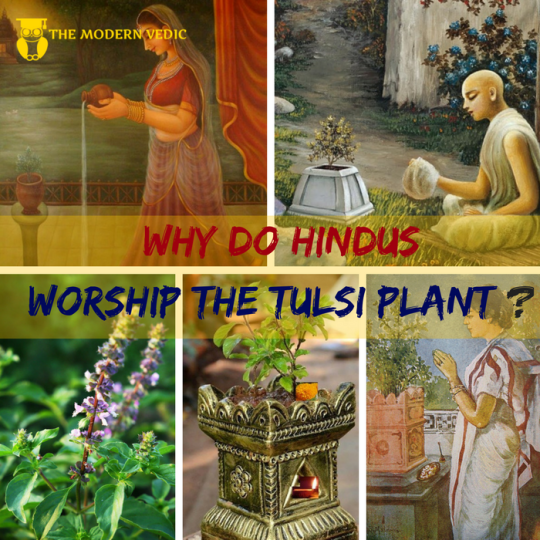
Today, in-spite of the fact that the mankind has reached extreme heights in medicine, the entire medical fraternity world over acknowledges the traditional and herbal characteristics of Tulsi. The properties of Tulsi, which the world has acknowledged today was known to Indians since ages. There is a sanskrit saying, tulanaa naasti athaiva tulasi - which means "that which is incomparable (in its qualities) is the tulsi".

For Indians tulasi is one of the most sacred plants. In fact it is known to be the only thing used in worship, which, once used, can be washed and reused again and again in pooja - as it is regarded so self-purifying. Tulasi is a gentle female energy, a sweet little goddess, and should be treated like the queen she is – the queen of medicinal plants. For she is also a plant of power, a powerful lady, a friend, a physician and an ally. When you have Tulasi plants around, you are protected, and she will bring beauty, health, elegance and grace into your life. Wherever there is Tulasi

Mayi, there is pavitrata, purity in the environment, for she is a great purifier, both of the body and of the environment. If you plant nine or eleven Tulasi trees in your garden the air will be pure within a wide radius, and bacteria-free. She is one of those trees that possess divine qualities to invoke the descent of devatas, illumined beings, and increase the spiritual vibrations in the vicinity. The Tulasi plant is extremely sensitive and aware, and is able to register the vibrations around her. She loves to listen to the Vedas, all Sanskrit chanting, to hear the name of God in the form of a kirtan, and she is especially fond of ragas sung to the accompaniment of the tampura. Stories pertaining to the Sacredness of Tulsi The Devi Bhagavata Purana regards Tulsi as a manifestation of Goddess Lakshmi, the goddess of wealth and principal consort of Vishnu. Once upon a time, King Vrishadhvaja—a devotee of the god Shiva—banned worship of all other deities except for that of his patron god,Shiva. An agitated sun god Surya cursed him that he would be abandoned by Goddess Lakshmi. Upset, Shiva pursued Surya, who fled, finally seeking shelter with Vishnu. Vishnu informed the deities that years had passed since Vrishadhvaja lived on earth. Vrishadhvaja and his heir-son and family were all dead and his grandchildren—Dharmadhvaja and Kushadhvaja—were now worshiping goddess Lakshmi to gain her favor. Lakshmi rewarded their efforts by being born as their daughters Tulsi (literally "matchless") and Vedavati (Tulsi to Dharmadhvaja and Vedavati to Kushadhvaja, respectively). In time, Tulsi gave up all her royal comfort and went to Badrinath to perform penance to gain Lord Vishnu as her husband. Lord Brahma was pleased with her penance but told her that she would have to marry the demon Shankhachuda before she could marry Vishnu. Sudama, a part-incarnation of Krishna (an avatar of Vishnu) was born on earth as the demon (Shankhachuda) due to a curse. Shankhachuda, who also pleased Brahma with his penance, was granted the Vishnu-Kavacha (armour of Vishnu) and blessed him, that as long as his wife's chastity was retained and Vishnu-Kavacha was on his body, no one could slay him. Shankhachuda and Tulsi were soon married. Shankhachuda was filled with pride and terrorized the beings of the universe. To rescue the universe, Shiva challenged Shankhachuda to war, while Vishnu went to Tulsi to break her chastity. Vishnu assumed the form of Shankhachuda and compelled Tulsi to have coitus. With her chastity broken, Shankhachuda was killed and Sudama was freed of his curse. In the middle of their love-making, Tulsi recognized the impersonator. Vishnu appeared in his true form and urged Tulsi to abandon her earthly body and return to his celestial abode as Lakshmi, his wife. Tulsi's mortal remains decayed and became the Gandaki River, while her hair transformed into the sacred Tulasi plant. Vishnu, the Lord of the Three Worlds, takes up abode in the village or the house where Tulasi is grown. In such a house no one suffers calamities like poverty, illness or separations from dear ones. ~Padmapurana, Uttarakhanda, 6-24-31-32 A Vaishnava legend relates Tulsi to the Samudra Manthana, the churning of the cosmic ocean by the gods and asuras (demons).
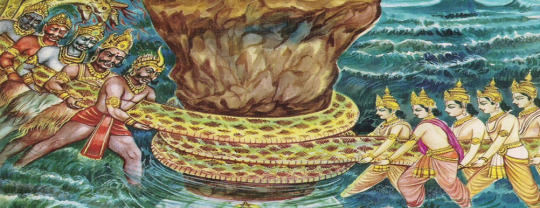
At the end of the churning, Dhanvantari rose from the ocean with Amrita (the elixir of immortality). Vishnu procured it for the gods, when the demons tried to steal it. Vishnu shed happy tears, the first of which fell in Amrita and formed Tulsi.

Lord Shiva and Goddess Laxmi She also symbolizes Goddess Lakshmi, the consort of Lord Vishnu. Those who wish to be righteous and have a happy family life worship her. Goddess Tulsi was married to the Lord with all pomp and show as in any Indian wedding. This is because of another legend, which states that Lord Vishnu blessed her to be His consort.
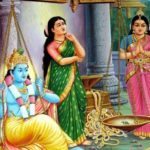
Weighing of Lord Krishna According to another legend, Satyabhama once weighed Lord Krishna against all her legendary wealth. The scales did not balance till a single tulsi leaf was placed along with the wealth on the scale by Rukmini. Thus tulsi played a vital role in demonstrating to the world that even a small object offered with devotion means more to the Lord than all the wealth in the world. The tulasi leaf has great medicinal values and is used to cure various ailments in the human body. Srimad-Bhagavatam 3.15.19 explains the special position of the Tulasi plant: “Although there are numerous flowering plants full of transcendental fragrance in the spiritual realm, they are aware that Tulasi is given special preference by the Lord, who garlands Himself with Tulasi leaves.” In her form as a plant, Tulasi always stays at the Lord’s feet and around His neck. (Her leaves and flowers decorate His feet and are strung into garlands to be worn around His neck.) The Vedic scriptures say, “Krishna gives Himself to a devotee who offers Him merely a Tulasi leaf and a palmful of water.” The wood of dead Tulasi plants is used to carve sacred beads devotees wear around their necks and use for chanting the Hare Krishna mantra. Tulasi is always grown at Krishna temples. Worship While tree worship is not uncommon in Hinduism, the Tulasi plant is regarded as the holiest of all plants. The Tulsi plant is regarded as a threshold point between heaven and earth. According to a traditional prayer, the creator-god Brahma resides in its branches, all Hindu pilgrimage centers are present in its roots, the Ganges flows through its roots, all deities in its stem and its leaves containing the Hindu scriptures - the Vedas in the upper part of its branches. Tulsi is often denoted as "the central sectarian symbol of Hinduism". The Vaishavas consider it as "a manifestation of god in the vegetable kingdom”.
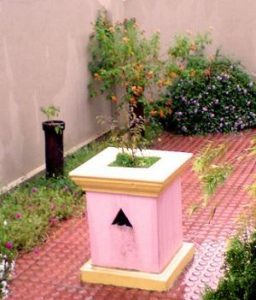
The Tulsi plant is grown in or near almost every Hindu house, especially by Brahmins and Vaishnavas. Sacred places where they are grown are also known as Vrindavan (grove of Tulasi). Vrindavan is a raised cuboid stone or brick structure often in middle of the house's courtyard or in front of the house. A person who waters and cares for the Tulsi daily is believed to gain moksha (salvation) and the divine grace of Lord Vishnu, even if he does not worship it. Traditionally, the daily worship and care of the plant is the responsibility of the women of the household. The plant is regarded as a "women's deity" and a "symbol of ideal wife-hood and motherhood". Though daily worship is prescribed, Tuesdays and Fridays are considered especially sacred for Tulasi worship. Rituals involve watering the plant, cleaning the area near the plant with water and cow dung (considered sacred) and making offerings of food, flowers, incense, Ganges water etc. Rangoli (decorative designs) of deities and saints are drawn near its foot. Devotees pray to Tulsi and circumbulate it, chanting mantras. The Tulasi plant is often worshipped twice in a day, in the morning and in the evening. In the 19th century, some families in Bengal regarded this plant as their guardian or family deity. In a British Indian census, North-Western Provinces recorded themselves as Tulsi worshipers and not belonging to Hindus, Muslims or Sikhs. In Worship of Other Deities Tulsi is especially sacred in the worship of Vishnu and his forms Krishna, Vithoba and other related Vaishnava deities. Garlands made of 10000 tulsi leaves, water mixed with tulsi, food items sprinkled with Tulsi are offered in veneration to Vishnu or Krishna.
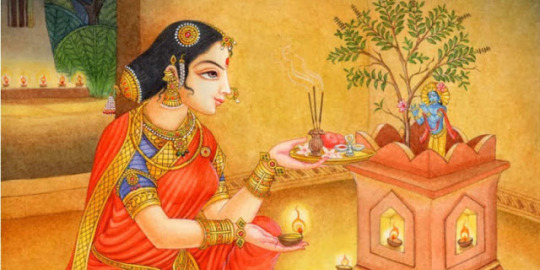
Vaishnavas traditionally use japa malas (a string of Hindu prayer beads) made from Tulsi

stems or roots called Tulsi malas, which are an important symbol of the initiation. Tulsi malas are considered to be auspicious for the wearer, and believed to connect him with Vishnu or Krishna and confer the protection of the deity. They are worn as a necklace or garland or held in the hand and used as a rosary. Tulsi's great connection with Vaishnavas is communicated with the fact that Vaishnavas are known as "those who bear the tulsi round the neck". Some pilgrims carry tulsi plants in their hands throughout their pilgrimage to Dwarka, the legendary capital of Krishna and one of the seven most sacred Hindu cities. There are conflicting accounts about Tulsi leaves being used in the worship of the god Shiva, a rival sect (Shaiva) god to the Vaishnava Vishnu. While Bael leaves are often offered to Shiva, some authors note that Tulsi may also be offered to him. Tulsi worship is sometimes used in the worship of lord Shiva, conveying the deity's omnipresence. Shiva's aniconic symbol - the linga - is sometimes prescribed to have made from the black soil from the roots of the Tulsi plant. However, Tulsi is a taboo in worship of the Devi - the Hindu Divine Mother as the pungent aroma of the Tulsi plant angers her. It is also important for the worship of Hanuman. In Orissa, the Tulsi plant represents all local deities and rituals to propitiate them, are offered in front of the plant. The Nayars of Malabar offer Tulsi plants to pacify evil spirits Festivals A ceremony known as Tulsi Vivah is performed by the Hindus between Prabodhini Ekadashi (eleventh lunar day of the waxing moon of Kartika) to Kartik Poornima (full moon in Kartika), usually on the eleventh or the twelfth lunar day. It is the ceremonial wedding of the Tulasi plant to lord Vishnu. Both the bride and the groom are ritually worshiped and then married as per the traditional Hindu wedding rituals. It marks the end of the four-month Chaturmas period, which corresponds to the monsoons and is considered inauspicious for weddings and other rituals. This day thus inaugurates the annual marriage season in India.

Tulsi Vivah In Orissa, on the first day of the Hindu month Vaishakha (April - May), a small vessel with a hole at its bottom is filled with water and suspended over the Tulasi plant with a steady stream of water, for the entire month. In this period, when a hot summer reigns, one who offers cool water to Tulasi or an umbrella to shelter it from the intense heat is believed to be cleansed of all sin. The stream of water also conveys wishes for a good monsoon. Various Names of Tulsi in the Hindu Mythology In the Hindu mythology, tulsi has been give various names. Some of them are : Vaishnavi ("belonging to Vishnu") Vishnu Vallabha ("beloved of Vishnu") Haripriya ("beloved of Vishnu") Vishnu Tulsi. The Tulsi with green leaves is called Shri-Tulsi ("fortunate Tulsi"). Shri is also a synonym for Lakshmi, Vishnu's principal consort. This variety is also known as Rama-Tulsi ("bright Tulsi"). Rama is also one of the principal avatars of Vishnu. The Tulsi with dark green or purple leaves and purple stem is called Shyama-Tulsi ("dark Tulsi") or Krishna-Tulsi ("dark Tulsi"). Krishna is also a prominent avatar of Vishnu. This variety is considered especially sacred to Krishna, as its purple color is similar to Krishna's dark complexion. Related Links Every part of the Tulsi plant is revered and considered sacred. Even the soil around the plant is holy. According to the Padma Purana, a person who is cremated with Tulsi

twigs in his funeral pyre gains moksha and a place in Vishnu's abode Vaikuntha. If a Tulsi stick is used to burn a lamp for Vishnu, it is like offering the gods lakhs of lamps. If one makes a paste of dried Tulsi wood (from a plant that died naturally) and smears it over his body and worships Vishnu, it is worth several ordinary pujas and lakhs of Godan (donation of cows). Water mixed with the Tulsi leaves is given to the dying to raise their departing souls to heaven.
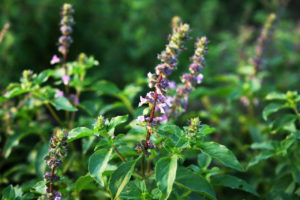
Just as Tulsi respect is rewarding, her contempt attracts the wrath of Lord Vishnu as well. Precautions have to be taken to avoid this. It is a taboo to urinate, excrete or throw waste water near the plant. Uprooting and cutting branches of the plant is prohibited. When the plant withers, the dry plant is immersed in a water body with due religious rites and rituals, as is the custom for broken divine images, which are unworthy for worship. Though Tulsi leaves are necessary for Hindu worship, there are strict rules for it. A prayer of forgiveness may also be offered to Tulsi before the act. Yanmule sarvatirhaani Yannagre sarvadevataa Yanmadhye sarvavedaascha Tulasi taam namaamyaham I bow down to the tulasi, At whose base are all the holy places, At whose top reside all the deities and In whose middle are all the Vedas. Basil and Ayurveda

From prehistoric times the earliest inhabitants of the Indian subcontinent have held plants in great reverence. Nature was worshiped by India’s primitive tribes. According to the Hindu mythology the God of Death, Yama, himself gives way to the ‘holiness’ of the sacred Tulasi. However, India is unique and it has maintained this reverence right up to the present day. Tulasi, which was once worshiped as a plant with ‘magical powers’, was analysed by the Ayurvedic physicians for its physical properties as well. Tulasi is known as

the Mother of Ayurveda. Basil has been used for thousands of years in Ayurveda for its diverse healing properties. It is mentioned in the Charaka Samhita, an ancient Ayurvedic text. Tulsi is considered to be an adaptogen, balancing different processes in the body, and helpful for adapting to stress. Marked by its strong aroma and astringent taste, it is regarded in Ayurveda as a kind of "elixir of life" and believed to promote longevity. It is an elixir for cough. the leaves when chewed after meals acts as a digestive, and when taken before and after cold water bath controls temperature in the stomach and prevents cold. If sprinkled over cooked food or in stored water, basil leaves prevent bacterial growth.Many Ayurvedic medicines are made from Tulasi and every part of her is useful.

Even the smell of Basil has a positive and soothing effect on the mind. In the early morning her leaves emit a type of oil. If you sprinkle water on her and then remain near her, preferably chanting a prayer or mantra, you will receive the benefit of this. Tulasi purifies the air day and night. Most plants take in oxygen during the night, but Tulasi gives out oxygen during both day and night, so you can keep her inside at night, especially when you are doing your japa, chanting and other sadhana. Wherever the aroma of Tulasi is carried by the wind, it purifies the atmosphere and frees all animals from all baser tendencies. ~Padmapurana, Uttarakhanda Read the full article
92 notes
·
View notes
Video
instagram
“It was at that point that I had a bit of a realization: a fanatic is a bad thing. Blindly doing something without understanding the reason behind it; to the point of violence. And I’ve realized that every type of fanaticism is bad.” Caitanya Bhagavata Adi 16.112-161 reading 11 September 2020 (full video on our YouTube channel) . . Daily #japa 8 AM Mon, Wed & Fri #reading 4 PM IST Everyone is welcome to join our everyday LIVE streams on YouTube.com/BBGovindaSwamiMedia Follow updates on #kirtan and other info in stories! . . #staysafe #keepupthespirit #spiritual #bhaktiyoga #getempowered #bhakti #meditation #HareKrishna #mantra #yoga #guru #vedic #monk #personalgrowth #realisation #chanting #HolyNames #heart #soul #transcendental #bbgovindaswami #govinda #swami #govindaswami (at Vrindavan) https://www.instagram.com/p/CFKQqfKAq0r/?igshid=mef5gv612q3p
#japa#reading#kirtan#staysafe#keepupthespirit#spiritual#bhaktiyoga#getempowered#bhakti#meditation#harekrishna#mantra#yoga#guru#vedic#monk#personalgrowth#realisation#chanting#holynames#heart#soul#transcendental#bbgovindaswami#govinda#swami#govindaswami
0 notes
Text
Greeting Some Majestic Temples of Jaipur
Rajasthan has been about various Rajas and Maharajas and their significant contributions to this land. Thus, their connection to this must visit place in India can be seen with the existence of exquisite palaces, forts and temples. The Maharajas along with adorning the city of Jaipur with gorgeous palaces and forts started to establish a few temples which turned out to be pompous pieces of artwork. Embellished with temples like Galta Ji, Pataleshwar, Govind Devji and Sun, Jaipur’s silhouette began to look commendable. Despite the development, this city has managed to maintain a balance between the ancient and modern times.
[ Checkout Hand Tailored Holiday Packages for Jaipur ]
This gorgeous city offers its Top 15 must visit temples for a pilgrim to explore:
Galta Ji Temple: Enjoy serendipity with the company of monkeys
Pilgrimage tourism in Jaipur includes visiting Galta Ji Temple where the shrine of Saint Rishi Galav is present. Located just 10kms away from the city and situated between two hills, the temple has been a tourist attraction for years. There are seven natural water tanks or kunds in this temple.Galta Kund is contemplated as the holiest kund because this is the only water tank of this temple which never goes dry. Makar Sankranti (Indian festival) attracts thousands of pilgrims to visit and douse in this kund as it is considered fortunate to do so. The upper and lower kunds are used by pilgrims to wash away their sins. Monkeys of the rhesus macaque species were featured in a National Geographic documentary after they invaded this place. They are often friendly and you can even feed them.
Also Read: Explore Other Religious Travel Spots in Rajasthan
Garh Ganesh: Seek Blessings From Lord Ganesha And Enjoy the View of Jaipur City
Close to Nahargarh Fort and Jaigarh Fort, Garh Ganesh is located atop a hill near Nahargarh hills. The temple is solely devoted to Lord Ganesha and a belief exists that he is present in a form of a small child – Vigra Purusha Kriti (trunkless). It was built by Maharaja Sawai Man Singh I and he placed the statue in such a way that with binoculars it is visible from Chandra Mahal of City Palace. Ever year on Ganesh Chaturthi a fair of five days is organized attracting a lot of devotees and tourists alike.
Also Read: Top 22 Most Popular Weekend Getaways from Jaipur
Birla Mandir: Visit An Architectural Marvel And Feel A Sense Of Tranquility
Blessing the city of Jaipur, Birla Mandir also known as Laxmi Narayan Temple is considered as one of the alluring temples of the city. Created by the renowned Birla family, the temple worships Lord Vishnu and goddess of wealth, Laxmi. While it is considered as an architectural beauty, this temple is made out of white marble and consists of three tall spires, depiction of Hindu scriptures on stained glass windows. Scenes and quotes from Bhagavad Gita are presented on the walls of the temple. The beauty of this temple not only brings a visual treat but also gives a feeling of relaxation.
Also Read: Famous Heritage Hotels for Luxurious Stay in Jaipur
Shila Devi Mandir : Admire The Uniqueness Of The Idol And Indulge its Rich History
Shila Devi Mandir is one of the famous Hindu temples in Jaipur. The temple has two legends out of which one states when Raja Man Singh I of Amber got defeated by King Kedar, he turned towards Mata Kaali for her blessings. His prayers were answered when the goddess appeared in his dreams and stated that a statue of hers was lying beneath the sea near Jessore (Now Bangladesh). She asked him to bring that statue and build a temple. A slab (Shila) was recovered from the sea. After bringing it back, it was thoroughly cleaned and an idol appeared. Thus the name Shila Devi was given to the temple.
Also Read: Tourist Attractions for History Buffs in Jaipur
Govind Devji Temple: Gaze Upon the Lord Krishna Idol Made by the Hands of His Great-Grandson
Being located in the complex of city palace, it’s a must visit to Govind Devji Temple. Locally known as Govind Devji, Lord Krishna is visited every year by his devotees from near and far. This temple is considered among the seven temples of Lord Krishna of Vrindavan. The idol was brought from Vrindavan to Jaipur by Raja Sawai Jai Singh II. The legend behind the idol of Lord Krishna goes like, when Shri Bajranabh -the great grandson of Lord Krishna was 13 years old, he inquired about the God’s appearance who was worshipped by everyone, from his grandmother- Lakshmana. While she was answering, Bajranabh started making the statue according to the descriptions his grandmother was giving. After the completion of the statue, only the feet resembled Lord Krishna, and this is how, this idol came to be known as “Madan Mohanji” . With the aim of making a better idol, another image was created by Shri Bajranabh in which the chest part looked similar to that of Lord Krishna, and this idol was called as “Gopinathji”. The third was called “Govind Devji” as the face was exactly like Lord Krishna. This was the idol that was carried to Jaipur by Sawai Jai Singh II.
Also Read: Everything You Need to Know About the City Palace of Jaipur
Tarkeshwar Mahadev Mandir: Find The Reason Of It Being A Favourite Amongst the Shiva Devotees and Seek Blessings
Tarkeshwar Mahadev Mandir has been a favourite of the devotees of Shiva. Since it is believed that the idol has emerged from the ground itself, it attracts a large number of devotees who come from near and far to pay homage. The temple is quite old and has marble flooring and a 9” diameter black stone Shivling with golden pictographs. There is also a brass idol of “Nandi” and big bronze gongs weighing 125 kg. Mahashivratri, Deepavali, Anna Kuta and Nrisingha leela are the occasions when a major rush of admirers and devotees could be seen.
Also Read: 20 Finest Hotels for Comfortable Stay During Jiapur Tour
Moti Dungri Temple: Admire The Unique Idol Of Lord Ganesha and Get Spiritually Awakened
Situated 6 km away from Jaipur, the Ganesha temple is situated on a hill which goes by the same name. The Moti Dungri temple gets its name from the fort surrounding the hills. The idol of the temple is said to be 500 years old and was brought from Gujarat. Seth Jai Ram Pallival was accompanied by Maharaja Madho Singh of Udaipur while bringing this idol to Jaipur. The construction of the temple was supervised by Pallival. Pilgrims offer a generous amount every year at this temple. The uniqueness of this idol is that the trunk of Ganesha is turned towards the right instead of being turned towards the left. Hence a large crowd of devotees are attracted to this temple. The structure of this must visit Nagara style temple resembles the structure of a scottish castle.
Also Read: Most Romantic Wedding Venues in Jaipur, Rajasthan
Sun Temple: Get Awestruck by the Scenic Beauty and Witness The City Getting Soaked in the Sunlight
One of the lesser known temples in Jaipur is the Sun Temple. This Hindu shrine is dedicated to the God Sun or Surya. The place is often used for praying or meditation and to have a good and soothing look of the city getting soaked in the sunlight. Going after sunset there, one can see the city bathed in the sun rays that brings a day to an amazing end. Situated on a hill , this temple is a part of Galta Ji Temple complex and the way to it is through traffic free and narrow lanes. Dating back to the 18th century, this temple was built above the flat valley on which Jaipur is established. Since the whole city is visible from the temple, you have the chance to see every famous monument from there.
Also Read: Amazing Facts about Jaipur’s Amer Fort
Kale Hanuman ji: Pay Homage to an Unusual Idol Of Lord Hanuman
Usually Lord Hanuman is idolised in orange or red colour but this temple has his idol in black and this makes it a must-visit in Jaipur. The temple was built 1000 years back and is located near Hawa Mahal. Few say that they feel connected to Lord Shiva and he can solve their every problem, be it physical or emotional. The temple has gained fame with its traditions and has been an active tourist spot as well. The story behind the establishment of this temple is that when Lord Hanuman asked the god of Sun on honorarium, the latter said that if he could bring his son- Shanidev to him. So when Hanuman went to meet the son, Shanidev attacked him which made him black. Even after this act of Shanidev, Hanuman brought him to his father who was impressed and gave his word that whosoever will worship Lord Hanuman on Saturday will not get affected from my oblique glance.
Also Read: Top Places that You Must Explore during Jaipur
Sanghiji-Shri Digambar Jain temple: Delve in the Spiritual World Of Jainism and Explore the Architectural Brilliance
Amongst the list of popular temples of Jaipur, Sanghiji: Shri Digambar Jain Temple is considered the most prominent Jain temples. Made out of red stone, this temple stands in Sanganer district which is 16 km from Jaipur. The main idol which is of Lord Rishabhanatha (Adinatha), the first Tirthankara is believed to be 4000 years old. This temple contains a smaller shrine which is guarded by Yakshas (snakes). The visitors are not allowed to visit the seven underground floors to the sacred temple as it is closed due to religious beliefs and it is assumed that a pre-declared ascetic Balyati Digambara saint can enter and for a limited period can bring out the idols. Three summit are present in the inner temple and in the centre a seven serpent hooded idol of Parshwanath is there.
Also Read: Popular Jain Temples in Rajasthan You Must Visit`
Akshardham Temple: Gawk at the Majestic Carvings and Enjoy the Feeling of Relaxation
Located in Vaishali Nagar, Akshardham Temple has showcased the fusion of architecture and culture. This temple is the abode of the Vedic Supreme god- Narayana. This temple has been a tourist attraction for its architectural beauty that consists of majestic carvings and sculptures. Being surrounded with nature, this place calm one’s mind. Along with tranquility, this place also offers a visual relief. The tourists feel attracted to this magnificent structure and never miss the chance to explore it. The main idol of Lord Narayana calms the pilgrim’s mind and blesses with a soothing feeling.With the walls being covered with mantras that are recited by the visitors, this temple never fails to amaze.
Also Read: Popular Travel Destinations in Jaipur
Ambikeshwar Mahadev Mandir: Explore and Seek Blessings at a Temple Built Before the Establishment Of Amer City
Amer Fort has been a tourist destination for years but the other enticement here is the Ambikeshwar Mahadev Mandir which happens to be present way before the establishment of Amer city. The legend says that when King Kakil Deo heard about a cow giving milk at a certain place, he ordered to dig up the place. He came across a Shivling upon excavating and commanded to build a temple there. Since shivling and cows are considered auspicious, this temple was built. Men have to peek through a window to look at the shivling. This temple also contains a water tank or kund, near the main temple, which gets filled to the brim during rainy season and overflows towards the main temple.The sudden disappearance of water has kept the pilgrims at their toes.
Also Read: Prominent Heritage Sites in Rajastan
Pataleshwar Mandir: Explore One of its Kind Shiva Temple Situated Below the Ground
The Pink city, Jaipur has various temples but this temple has gained too much of attention that on the festival of Maha Shivratri it is flooded with pilgrims. This temple is dedicated to Lord Shiva and was built around 400 years ago. No evidence has been found on who built it and why but the temple is below the ground level. Around 20-22 feet deep below, this temple was founded in 1977. Eventually to protect it, a wall like structure was built around it since it is still below the ground level. Due to this the temple is named as Pataleshwar Mandir.
Also Read: Best Outdooe Activities to Try in Jaipur
Jagat Shiromani Temple: Relish the Pompous Piece of Architecture
This Hindu temple situated at Amer Fort has been attracting devotees of Krishna. The temple was built by Queen Kanakwati, wife of Maharaja Man Singh I around 1599-1608. The idols present within this temple are of Lord Vishnu and Lord Krishna. According to the legend, this was the same idol of Lord Krishna which Meerabai used to worship in Mewar. The temple is an excellence of architecture and has two entrances. The temple has a sanctum, vestibule and mandapa and carrier of Lord Vishnu- Garuda has been carved in front of the temple. This also contains a statue of Meera Bai.
Also Read: Rajasthan Tourism at a Glance
Kalki Temple: Unravel the Mystery of the Crack on the Left Leg of Devdutta, the Vehicle of Kalki
Kalki temple is devoted to the tenth Avatar of Lord Vishnu which is still to be incarnated. While establishing the city, Sawai Jai Singh II built this temple opposite the City Palace’s eastern entrance. Made out of marbles and red stones, the temple contains two shikharas where one is bigger than the other. Despite being built in the same North Indian temple style, the presence of two domes makes it unique. Devotees of Lord Vishnu often visit this temple which holds various tales to it. According to the legends, at the entrance there is a statue of Devdutta horse which is believed to be the ride of Kalki. At its rear left leg you can see a crack. Few say that when this crack heels, Lord Vishnu will incarnate and end this kalyug. Having a simple yet astonishing architecture, this temple marks a place in your must visit pilgrim site list in Jaipur.
[ Grab Best Deals on Rajasthan Holiday Packages ]
While exploring the city, I came across these must visit temples and none have failed to amaze me. If you are planning to visit Jaipur add these to your to-visit list. Exploring the city like never before, you might need some help. So, to know about the best deals, contact Tour My India at +91-9212777225 or write us at [email protected]. If you think that we have missed something, tell us know by dropping a comment in the section below and if you liked this blog, then please give it a thumbs up and share.
The post Greeting Some Majestic Temples of Jaipur appeared first on Tour My India.
from Tour My India
0 notes
Text

Krishna Valley Resort is not just a hotel, it's a destination for your dream wedding in Vrindavan. Our Luxurious resort nestled in the heart of the sacred city of Vrindavan is perfect for wedding events, including Mehendi, Sangeet, and celebrations. Our resort is designed to provide a blend of traditional Indian elegance and modern amenities ideal for Vedic wedding and Luxury wedding.
0 notes